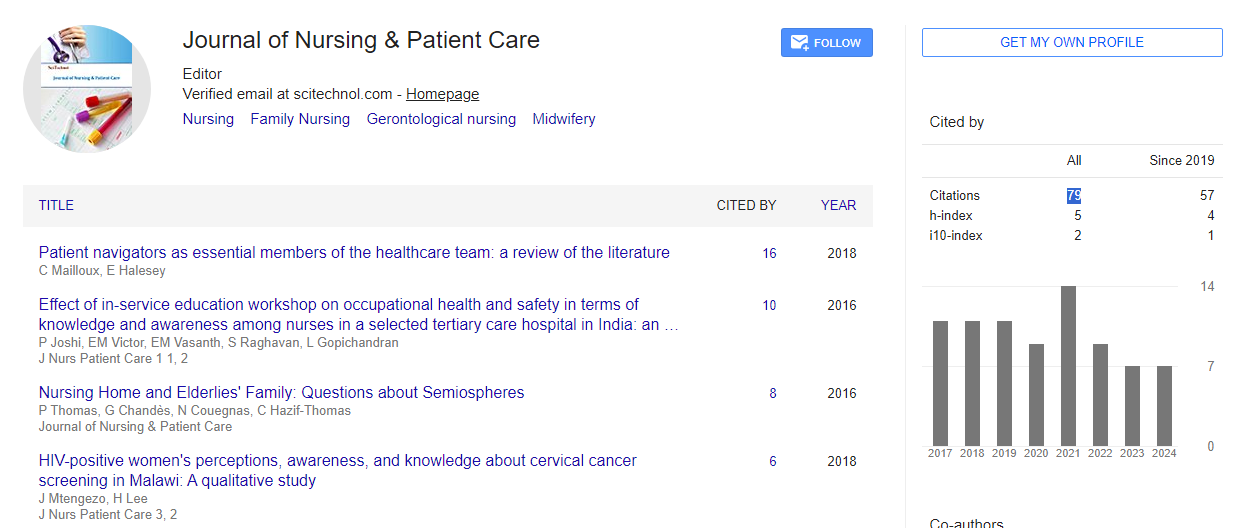Opinion Article, J Nurs Patient Care Vol: 9 Issue: 3
Patient-Centered Care in Cardiac Nursing: Enhancing Communication and Emotional Support for Patients and Families
Sofia Charlotte Pedersen*
1Department of Cardiology, Aarhus University Hospital, Nørrebrogade 44, 8000 Aarhus, Denmark
*Corresponding Author: Sofia Charlotte Pedersen,
Department of Cardiology,
Aarhus University Hospital, Nørrebrogade 44, 8000 Aarhus, Denmark
E-mail: s.charlotte.pedersen@telenor.dk
Received date: 19 August, 2024, Manuscript No. JNPC-24-149698;
Editor assigned date: 21 August, 2024, PreQC No. JNPC-24-149698 (PQ);
Reviewed date: 04 September, 2024, QC No. JNPC-24-149698;
Revised date: 12 September, 2024, Manuscript No. JNPC-24-149698 (R);
Published date: 19 September, 2024, DOI: 10.4172/2573-4571.1000074.
Citation: Pedersen CS (2024) Patient-Centered Care in Cardiac Nursing: Enhancing Communication and Emotional Support for Patients and Families. J Nurs Patient Care 9:3.
Description
Patient-Centered Care (PCC) is increasingly recognized as a critical component in nursing, particularly within the field of cardiac nursing. This approach indicates the importance of understanding and addressing the unique needs, preferences and values of patients and their families. By enhancing communication and emotional support, cardiac nurses can significantly improve patient outcomes, satisfaction and overall quality of care. In cardiac nursing, the complexities of heart disease necessitate a comprehensive approach that considers not only the physical aspects of care but also the emotional and psychological needs of patients and their families. Heart disease can be life-altering, causing anxiety, fear and stress for both patients and their loved ones. Therefore, a patient-centered approach that prioritizes open communication and emotional support is essential for promote flexibility and promoting recovery.
One of the most effective ways to improve communication is through active listening. Nurses should create an environment where patients feel heard and understood. This involves paying attention, asking open-ended questions and providing feedback that reflects the patient's concerns. Patients often struggle to understand medical language and complex treatment plans. Cardiac nurses should aim to communicate information in a way that is clear and accessible. Using simple language, visual aids and teach-back methods can help ensure that patients comprehend their conditions and treatment options. For instance, nurses can use diagrams to explain how a heart functions and how specific treatments aim to improve cardiac health.
Family members often play an important role in a patient's care journey. Nurses should encourage family involvement by providing them with relevant information and inviting them to participate in care discussions. This not only enhances communication but also fosters a supportive environment where families can feel empowered to assist their loved ones. Cardiac patients may experience a range of emotions, including fear, anxiety and depression. Nurses should be attentive to these emotional needs and recognize when a patient may require additional support. Regularly assessing emotional well-being through simple conversations can help nurses identify those who might benefit from counseling or support groups. A positive and supportive care environment can significantly influence a patient’s emotional state. Cardiac nurses should strive to create a welcoming atmosphere, using comforting language and gestures. Small actions, such as offering a reassuring smile or taking extra time to sit with a patient, can make a significant difference in how supported they feel. Encouraging patients to connect with others who have similar experiences can provide valuable emotional support. Nurses can facilitate this by organizing support groups or connecting patients with community resources. Hearing from peers who have faced similar challenges can help patients feel less isolated and more hopeful.
Empowering patients to take an active role in their care is a key aspect of patient-centered care. Nurses can encourage this by involving patients in decision-making processes related to their treatment plans. Providing information about options and potential outcomes allows patients to make informed choices that align with their values and preferences. This sense of ownership can lead to increased adherence to treatment and improved health outcomes.
Conclusion
Patient-centered care in cardiac nursing is essential for enhancing communication and emotional support for patients and their families. By prioritizing active listening, clear communication and emotional recognition, nurses can create an environment that promote healing and flexibility. Furthermore, involving families and empowering patients to participate in their care can lead to better health outcomes and increased satisfaction. As the field of cardiac nursing continues to evolve, the emphasis on patient-centered approaches will remain essential in delivering high-quality, compassionate care. By embracing these principles, cardiac nurses can significantly improve the overall experience for patients facing the challenges of heart disease.
 Spanish
Spanish  Chinese
Chinese  Russian
Russian  German
German  French
French  Japanese
Japanese  Portuguese
Portuguese  Hindi
Hindi 